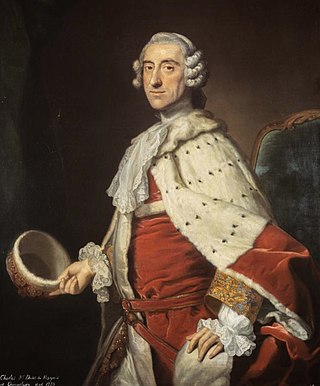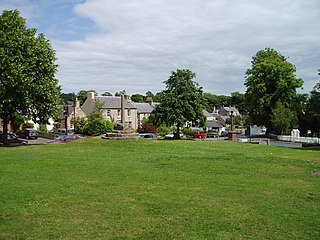Notes
This article includes a list of references, related reading, or external links, but its sources remain unclear because it lacks inline citations .(December 2016) |
A burgh of regality is a type of Scottish town.
They were distinct from royal burghs as they were granted to "lords of regality", leading noblemen. (In distinction, burghs of barony were granted to a tenant-in-chief, a landowner who held his estates directly from the crown, and had fewer civil and criminal law powers). They were created between 1450 and 1707, and conferred upon the landowner varying trading rights, such as the right to hold weekly markets or to trade overseas.
Burghs of regality possessed higher jurisdictional rights in liberam regalitatem, amounting to complete criminal jurisdiction except for treason. These rights were abolished by the Heritable Jurisdictions (Scotland) Act 1746, after which the burghs enjoyed only the jurisdictional rights of burghs of barony.
The titles are redundant today but remain in descriptive use.
This article includes a list of references, related reading, or external links, but its sources remain unclear because it lacks inline citations .(December 2016) |

A royal burgh was a type of Scottish burgh which had been founded by, or subsequently granted, a royal charter. Although abolished by law in 1975, the term is still used by many former royal burghs.

A burgh is an autonomous municipal corporation in Scotland, usually a city, town, or toun in Scots. This type of administrative division existed from the 12th century, when King David I created the first royal burghs. Burgh status was broadly analogous to borough status, found in the rest of the United Kingdom. Following local government reorganisation in 1975, the title of "royal burgh" remains in use in many towns, but now has little more than ceremonial value.

Charles Grant, 1st Baron Glenelg PC FRS was a Scottish politician and colonial administrator who served as Secretary of State for War and the Colonies

In England, Wales and Ireland a county palatine or palatinate was an area ruled by a hereditary nobleman enjoying special authority and autonomy from the rest of a kingdom. The name derives from the Latin adjective palātīnus, "relating to the palace", from the noun palātium, "palace". It thus implies the exercise of a quasi-royal prerogative within a county, that is to say, a jurisdiction ruled by an earl, the English equivalent of a count. A duchy palatine is similar but is ruled over by a duke, a nobleman of higher precedence than an earl or count.

Dysart is a town and former royal burgh located on the south-east coast between Kirkcaldy and West Wemyss in Fife, Scotland. Dysart was once part of a wider estate owned by the St Clair or Sinclair family. They were responsible for gaining burgh of barony status for the town towards the end of the 15th century.

Anstruther is a small coastal resort town in Fife, Scotland, situated on the north-shore of the Firth of Forth and 9 mi (14 km) south-southeast of St Andrews. The town comprises two settlements, Anstruther Easter and Anstruther Wester, which are divided by a stream, the Dreel Burn. With a population of 3,500, it is the largest community on the Firth of Forth's north-shore coastline known as the East Neuk. To the east, it merges with the village of Cellardyke.

The House of Burgh or Burke was an ancient Anglo-Norman and later Hiberno-Norman aristocratic dynasty who held the earldoms of Kent, Ulster, Clanricarde, and Mayo at various times, provided queen consorts of Scotland and Thomond; many kings of Britain and multiple other royals, and played a prominent role in the Norman invasion of Ireland.
A county corporate or corporate county was a type of subnational division used for local government in England, Wales, and Ireland.

Ulick MacRichard Burke, 1st Marquess of Clanricarde, 5th Earl of Clanricarde, 2nd Earl of St Albans, was an Anglo-Irish nobleman who was involved in the Wars of the Three Kingdoms. A Catholic Royalist who had overall command of the Irish forces during the later stages of the Cromwellian conquest of Ireland, he was created Marquess of Clanricarde (1646).

Charles Douglas, 3rd Duke of Queensberry, 2nd Duke of Dover, was a Scottish nobleman, extensive landowner, Privy Counsellor and Vice Admiral of Scotland.
Scottish burghs were urban settlements enjoying trading privileges from medieval times until 1832. They regulated their own affairs to a varying extent according to the type of burgh concerned. The Scottish burghs were abolished in 1975. Burghs produced many types of historical records. Medieval burghs started to appear in the twelfth century. They provided an environment in which merchants and craftsmen could live and work outside the feudal system. However each burgh had to pay significant sums of money to the post holder of its original creator. This could be the crown, an abbot or a bishop, or also a secular baron.
A burgh of barony was a type of Scottish town (burgh).
The British nobility is made up of the peerage and the (landed) gentry. The nobility of its four constituent home nations has played a major role in shaping the history of the country, although the hereditary peerage now retain only the rights to stand for election to the House of Lords, dining rights there, position in the formal order of precedence, the right to certain titles, and the right to an audience with the monarch. More than a third of British land is in the hands of aristocrats and traditional landed gentry.

Ancrum is a village in the Borders area of Scotland, 5 km (3.1 mi) northwest of Jedburgh.
A moot hill or mons placiti is a hill or mound historically used as an assembly or meeting place, as a moot hall is a meeting or assembly building, also traditionally to decide local issues. In early medieval Britain, such hills were used for "moots", meetings of local people to settle local business. Among other things, proclamations might be read; decisions might be taken; court cases might be settled at a moot. Although some moot hills were naturally occurring features or had been created long before as burial mounds, others were purpose-built.
Scotland has eight cities. Edinburgh is the capital city and Glasgow is the most populous. Scottish towns were granted burghs or royal burgh status by Scottish kings, including by David I of Scotland and William the Lion.
A regality was a territorial jurisdiction in old Scots law which might be created by the King or Queen only, by granting lands to a subject in liberam regalitatem, and the tract of land over which such a right extended.

A drowning pit, drowning pool, murder-pool or murder hole was a well or pond specifically for executing women and girls under Scottish feudal laws. Rivers or lochans were used if conveniently situated near to a moot hill, where the baronial court dempster would announce the death penalty. The term fossa was also used, as in the phrase ‘furca and fossa’.
The Barony of Muirton is a Scottish feudal barony near Forres along the Findhorn River in Moray.